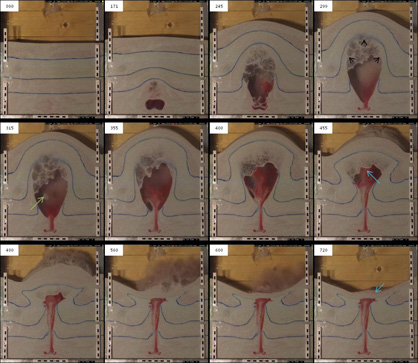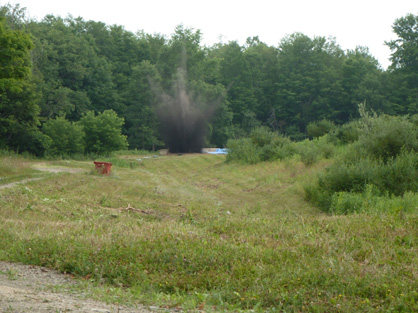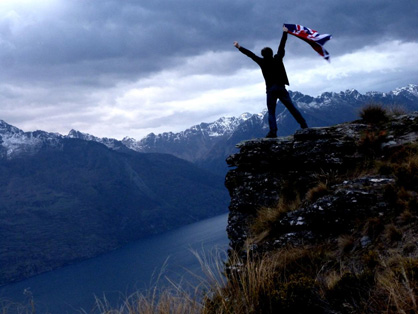This page was last updated by Robin while he conducted his PhD research at the Department of Geology, University of Otago. Find out what Robin is doing now on our Alumni page
 MSci ARSM FGS
MSci ARSM FGS
24, British citizen.
PhD Title (Working): Investigating the cratering and thermodynamics of the phreatomagmatic 1886 Rotomahana eruption
Supervisor:James White
Email: r.c.andrews@btinternet.com
Phone: +6421867843
Photography website:http://www.shrinkinguniverse.com/
Introduction
Dedicated, enthusiastic geology postgraduate from Imperial College (First Class Honours) with a strong, global academic background and a comprehensive history of scientific and photojournalistic ventures and affiliations. Currently undertaking a PhD in experimental volcanology at the University of Otago under Assoc. Prof. James D.L. White. Primary scientific interests include volcanology, planetary science, evolutionary theory, and climatology. I am a fellow of the Geological Society of London, an Associate of the Royal School of Mines (ARSM), and have recently been conferred the title of Ambassador Scholar by Imperial College. I was granted membership to Mensa at the age of 10 with an IQ of 162.
Passionate interest in travel and travel photography has resulted in frequent visits to many countries around the world across five different continents. The International Anthem, an original 120,000-word novel based on this extensive travel, is currently undergoing consideration for publication. During my third academic year at IC, I lived in Vancouver, Canada, as an international student to the University of British Columbia; my PhD takes place in the United States of America, Germany, Japan, and my current academic residence, New Zealand. Self-maintained, award-winning photographic portfolio website is viewable at www.shrinkinguniverse.com; several photographs have won awards from The Independent, Photobox and Bradt Travel Guides. Commended entry for the national Science Writer Awards 2007 (Daily Telegraph) was placed among the top 50 entries. Articles on anthropogenic climate change, science communication, politics and secularism have been and are frequently published in UK and online press, including an article featured by Prof. Richard Dawkins and an interview by the European Geological Union.
Relevant Academic Background
With a top-class MSci degree from a world-leading institution, I have a proven track record at adapting to any kind of scientific task, gaining the highest-tier grading in studies in volcanology, petrology, geochemistry, cosmology, palaeobiology, climatology, mathematics, sedimentology and fieldwork, among many others. Prior to working in the University of Wuerzburg's Vulkanologisches Labor, firing high pressure jets into pre-arranged glass bead stratigraphy to investigate the dynamics of maar-diatreme system formation events, I have worked in Imperial College's numerical modelling computational labs to investigate the genesis of shallow, evolved magmas, and the University of British Columbia's volcanological labs, wherein I used high-temperature ovens and high-pressure simulators to investigate vulcanian eruptions in the Coast Mountains.
My fieldwork experience includes a wide-range of detailed mapping and data gathering, from a transect across the Apennine Mountains, Italy, to observing and studying a live eruption at Sakurajima volcano in Japan. A scholarship from Royal Dutch Shell for mapping work in Canada, the conferring of the title of Ambassador Scholar from Imperial College, and admission as a fellow into the Geological Society of London, among many other accolades, demonstrate the recognition of my academic prowess within a range of significant organisations.
"It has long since come to my attention that people of accomplishment rarely sat back and let things happen to them - they went out and happened to things." - Leonardo Da Vinci.
Academia
PhD Title (Working)
Investigating the cratering and thermodynamics of the phreatomagmatic 1886 Rotomahana eruption. Commenced September 2011.
Outline of the unique significance of the project
I am currently undertaking a PhD under Assoc. Prof. James White, investigating cratering dynamics and the thermodynamic system behind the 1886 Rotomahana (New Zealand) eruption; the objectives are to review current efforts to better constrain the eruption dynamics occurring during this and similar maar-forming events, whilst using analogue experiments – field-scale explosions conducted at Buffalo's (USA) ECLIPSE field site with Greg Valentine, and bench-scale explosions conducted at Wuerzburg, Germany – to produce new cratering mechanism data. The final thesis will combine experimental physics, analogue experimentation, numerical modelling, mathematical predictions, and fieldwork to form a comprehensive framework for the physics behind maar-diatreme explosive events, and perhaps other types of discrete volcanic eruptions.
Current Primary Research Focus
Discrete volcanic eruptions – those exhibiting non-steady state conditions – are relatively poorly understood volcanological phenomena. Whereas the nature of the fragmentation zone in steady state, open vent volcanic eruptions has been comprehensively assessed through the use of fieldwork and analogue experimentation over the last few decades, the nature of the explosion-generating zone of the various types of discrete eruption are comparatively unknown. In particular, the physical dynamics and characteristics of established jets and plumes in discrete volcanic eruptions are still currently open to a wide range of interpretations. Using analogue experimentation and a strong background in physics, I hope to assess the current models of maar-diatreme eruptions and update them through the production of new data.

Firing glass beads into pre-arranged stratigraphy, filmed with high speed cameras, in order to simulate the kinetic physics of diatreme formation
Progress to date (as of March 2013)
- Four academic papers are currently nearing completion: first, a paper concerning the inviscid dynamics of simulated maar-diatreme systems (targeted at the journal Nature Geoscience); second, a substantial paper investigating the mathematical and physical relationships existing within simulated maar-diatreme systems (targeted at the journal Nature Geoscience); third, comparing field evidence to simulated geological features in maar-diatreme systems (targeted at the journal Geology); fourth, a letter implying a link between maar-diatreme volcanism and certain aspects of Ionian volcanism (targeted at the journal EPSL). The first three papers are based on data obtained from the aforementioned experimental work in Germany and the United States. Fieldwork in the Hopi Buttes area of Arizona, and fieldwork and conferences in both Japan (IAVCEI 2013) and California (AGU 2013), will feature or have featured in the development of my scientific profile this year.
- My PhD is very experimental-based, focusing on the physics of the eruptive styles of maar-diatreme systems. As a result, I have thoroughly and comprehensively researched maar-diatreme volcanism and the physical analysis of cratering, volcanic ballistics, and thermodynamics. A literature review was composed within the first two months, which served as a way of narrowing down the characteristics of maar-diatreme systems that a) are most poorly understood, and b) can be addressed through the use of analogue experiments.
- The most comprehensive review of maar-diatreme volcanism had just been published the same year by James D.L. White, my supervisor, so in effect, the first few months of my PhD tenure consisted of learning and understanding as much about my chosen topic as possible, whilst teaching myself advanced thermodynamics and mathematics, and forming potential physical models for maar-diatreme eruptions that had not yet been conceived within the scientific literature.
- A punchy ideas paper, entitled “Dynamic segregation in debris jets in volcanic systems: Insights from analogue experiments”,aimed at publication in the journals Nature Geoscience or Science, was composed in the fortnight after returning from months-long analogue experimental work at Physikalisch-Vulkanologisches Labor, Universität Würzburg, Germany, based on the emergence of “secondary debris jets”, a phenomenon which has not been recorded previously in any known analogue experimentation. This sums up my research to date most effectively, and as such, the draft manuscript is attached to this progress report for your perusal. Within a short space of time, I used the physics of military explosions to form a model hoping to partly explain the formation of maar-diatreme systems – currently, very poorly-understood volcanological phenomena – which has been partially tested during the experimental work in Germany.
- I have presented initial ideas for my PhD in poster form at the GSNZ conference in Nelson, December 2011.
- I gave a very well-received introductory lecture to my PhD and its ultimate objectives at the 4th International Maar Conference in Auckland, January 2012.
- For three conferences and some upcoming fieldwork, I have been awarded grants by the IAS based on the relevance and uniqueness of my research.
- I have been recommended by my supervisor for a Marie Curie Fellowship-funded research post at the INGV in Rome, investigating the ballistics of eruptions at Mount Etna and Stromboli.
- I have undertaken scientific demonstrating (at undergraduate level) at the university.
- I have happily maintained my obligation to Imperial College, London, my previous university, to give public science communication lectures and contribute scientific understanding articles to the popular press around the world in my role as an Ambassador Scholar.

Using PETM/TNT charges to create some man-made maars, in Buffalo, NY.
